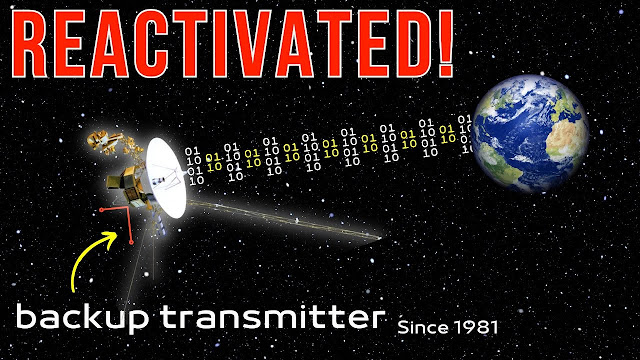Voyager 1 is a spacecraft launched by NASA in 1977 and recently had contact with Earth through a supplementary transmitter that had not been used since the early 1980s. This achievement celebrates not only one of the longest-lived space missions of human history but also celebrates the engineering genius behind this feat within NASA. Voyager 1 has traveled for more than 40 years, moved deeper into interstellar space, and returned unprecedented data concerning the system beyond our own. Last week's "phone home" is a poignant reminder that technology from nearly a couple of decades back can continue revealing the mysteries of the cosmos.
Voyager's Historic Journey
Voyager 1's twin Voyager 2 was mainly built to explore the Jupiter and Saturn during a four-year expedition. However, these two space machines moved further into the unknown after they accomplished their primary mission. With a golden-plated disc hosting sounds, images, and messages of Earth, Voyager 1 is the farthest human emissary sent to space. After crossing the heliopause that marked our solar system's boundary, Voyager 1 continued to send useful data to scientists, on interstellar space, hence uncovering conditions outside our solar system.
Recently, a new turn was added to its history, however, as it used a standby transmitter for the first time. The equipment is already considered by engineers as standby since it hasn't been utilized since the early days of the mission. It's a difficult and risky call to bring it back to use.
Why the Backup Transmitter?
This was because the backup transmitter for Voyager 1 was turned on, following its original communication system's gradual degradation due to strong radiation and cold in the vast space. When the signals began to fade, NASA engineers developed new and creative solutions that would enable them to extend the line with Voyager 1. It appeared improbable that they could recycle the backup transmitter because there was no means to test or repair equipment billions of miles away.
But as the vital data transmissions from Voyager began to falter, the team of engineers made a calculated gamble. They went through each previous record of the mission meticulously and designed a way to send a command sequence to Voyager 1 to switch communication to the backup transmitter.
The Long-Distance Signal
Activating the backup transmitter is no small feat, especially when Voyager 1 has moved beyond 14 billion miles away from Earth. The immense distance involved meant that any signal coming from Earth took over 20 hours to reach the spacecraft and another 20 hours for its response to return. A significant communication lag then added a new layer of complexity, since every command needed to be very carefully calculated, executed, and confirmed with almost a two-day delay.
Engineers at NASA worked through tens of thousands of test simulations to try to ensure the success of the command. They also prepared for failure scenarios that may crop up from aging technology. Having sent the command, it was a tense wait time of 40 hours. To their surprise, Voyager 1 responded just fine, but it found that from then on, its backup transmitter was assigned with the task of receiving data.
Engineering Feats and Implications for Future Space Missions
This achievement once again vindicates NASA's superiority in engineering design and, more specifically, the manner in which age-period technology is handled and also abusive environments. The successful activation of Voyager 1's standby transmitter proves that its design could withstand any amount of abuse and is a testament to the continued legacy of very early space exploration technology.
Successful activation has many far-reaching implications:
The extension of the mission of Voyager 1 will now continue to transmit data, perhaps for several more years. That is important, since the data from interstellar space alone provides some information regarding conditions in the galaxy beyond our solar system.
Inspiration for Future Missions: The fact that systems might be restarted from a distance could influence design and longevity strategies for future interstellar missions. Knowing backup systems could be reusable decades into a mission will change the way spacecraft are built and equipped for long-term exploration.
Expanding Horizons for Engineers: It may not be surprising that turning on Voyager 1's transmitter demonstrates how an apparently anachronistic system can have unpredictable utility. That lesson inspires engineers to design new systems with flexibility and redundancy, which in turn means a potential for mission lifetimes to expand much longer into the future.
What's Next for Voyager 1?
Voyager 1 has been returning some vital information about cosmic rays, magnetic fields, and plasma waves in the interstellar medium. Now that the backup transmitter is working, NASA will continue to receive data on those phenomena for as long as is possible. The information would help scientists better understand the boundary regions of our solar system, especially since the probe ventures further into unknown regions.
With this "miracle of a secondary transmitter," as the mission team expects Voyager 1 to stay operational until about 2025, when its power sources will likely be depleted permanently, the world's most distant spacecraft has breathed new life into it, giving humans another chance to push into the mysteries of the galaxy.
Humanity's Reach into the Cosmos
Voyager 1 remains operational, a testament to human
pioneering spirit and the innate desire to always explore beyond our world.
Indeed, such a feat is an inspiring tribute to the ingenuity of scientists and
engineers who have designed and maintained such extraordinary spacecraft.
Through Voyager 1, we stand connected to the farthest reaches of our galaxy,
reminding us that our journey in discovering the cosmos is far from over.





0 Comments